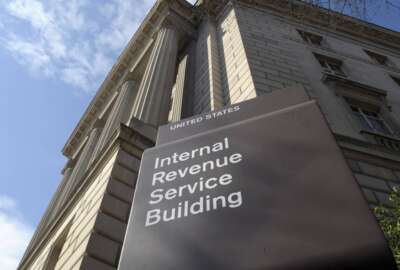Your federal life is about to get a bit more expensive
"There are still some challenges with regard to retirement services and customer service," NARFE's John Hatton said.
No doubt you’ve heard. Big price hikes for health insurance for federal employees coming next year. Big ones. Open season coming soon, brings lots of questions. For retirees, a smaller cost of living increase is likely. More on the Federal Drive with Tom Temin from the vice president of the National Active and Retired Federal Employees Association, John Hatton.
Interview transcript:
Tom Temin And let’s talk about those premiums. Now, the hikes are average anywhere, are well known now. Open season about to start another few weeks. What’s your take and what are you telling members?
John Hatton Well, certainly disappointing to see a huge increase in premiums, you know, 13.5% on the enrollee share on the federal side and 11.1% for the postal side. And, you know, we’re expecting a cost of living adjustment coming in around 2.5%. You know, maybe a point percentage, you know, a 10th of a percentage point different than that depending on what the final numbers are. That’s certainly going to be hard to take that premium increase with that cost of living adjustment. So, you know, I think seeing that type of health care inflation go up at rates that’s that’s not represented and other goods and not represented in that COLA is challenging.
Tom Temin And it’s also challenging because, you know, this is generally a better risk pool for the insurers, federal employees.
John Hatton Yeah. So we always you know, OPM always puts out data on what private sector employers or employees are paying for their health insurance. And it’s a little above that where you’re taking into account just active federal employee, just active employee. So private sector employer health insurance, you know, is going up 8 or 9%, you know, based on surveys. A similar system as CalPERS, which covers both retirees and and active employees in California public sector. And that’s going up a similar amount. And so, you know, one of the good parts about the HBP is it’s, you know, you get to choose among different plans. We always tell our members, take a look, you know, this might be a great year to look at a lower price plan because you have those additional choices. And so but really the plans, it’s private insurance that you’re getting a government contribution for. It’s going to reflect the prices that are existing in the private market for health insurance. And so increase utilization, increase prices that are happening. You know, those insurers can help tamp those prices down, but they’re also subject to them as well.
Tom Temin Yeah, utilization is one thing, and we don’t really know what the population of insurers themselves is yet. Some of them might have dropped out and maybe, you know, with fewer there, there’s less competition or simply the ones left in are the ones that are charging what the market has to do in order to maintain the coverage. And those that couldn’t meet that just aren’t there, we don’t know. But these are questions, I think.
John Hatton Yeah. I mean, I think the the insurance plans are yeah, the costs for each plan are based on who is enrolled in them. So if the costs are going up for the enrollees on what you’re paying for health care costs, it’s going to be reflected in them as premiums. You know, one of the reasons the postal side premium increase is less overall, particularly the general insurance closer is because the Postal Service Reform Act is requiring or providing incentives for enrollment in Medicare in the future. A lot of people enroll. So at last look or out 28,000 postal and do it and took advantage of a special fear to take Medicare without a late penalty. That’s help bringing down some of the costs on the postal side of things which is good news for those in that plan. I know there’s a lot of people who need to shift over to this Postal Service health benefits plan 2025. And I know there’s a lot of confusion, a lot of worry, hopefully seeing some of those premiums be a little bit lower of an increasing move. So high increase is reassuring seeing some of the plans that are going to be available where more than 90% of people are going to have basically the same plans available in the postal side as hopefully a bit reassuring. There’s still some details to be finalized by OPM, the Postal Service health benefits, particularly as it relates to drugs. So there’s there’s still a little wait and see on for some of that stuff. And there’s still may be some cases where people are forced to change plans.
Tom Temin Right. We don’t know whether open season will be affected by that pending rule. With respect to, again, the Postal Service having prescription drug coverage. That’s the question.
John Hatton Well, the all postal annuitants will have prescription drug coverage. The question is, are you going to be essentially required to have it via Medicare or can you retain your existing drug coverage? So in 2024, FHB plans started to offer this new Medicare prescription drug plan coverage and as a supplement to their existing drug coverage. But enrollees in FHP have the option to opt out and keep their existing coverage if they would be subject to higher surcharges for having higher incomes. If they wanted to use drug company discounts and get reimbursement for their insurance company. For OPM’s proposed rule, postal insurance wouldn’t have that same option to opt out, so they’d be forced to have the Medicare prescription drug coverage. Now, though, if they want that to be equal or better than the postal Service for drug coverage. But there are at least a couple of reasons people may want to opt out. And the question is, are is that choice going to be available on the postal side or is it not? We commented on that rule, and I’ve been advocating for retaining that choice for post on new dates and we’ll see what the final rule says.
Tom Temin We are speaking with John Hatton, vice president of the National Active and Retired Federal Employees Association. And with respect to the COLA, again, that’s coming out for retirees, I mean, the good thing about a smaller COLA is that in theory it means inflation is less and it’s only supposed to keep you going, but it doesn’t feel like inflation is all that tame yet.
John Hatton Now it still seems it’s there. And I think part of that is that, you know, prices haven’t gone down. Right? There’s a there’s a lot of high inflation. And so if you’re looking back five years ago and while the prices now compare to them are much higher, you know, the change in prices over the last year seem to be moderating. But again, we’re still seeing some of this increased costs and health care. And, you know, we’ve long advocated for taking a look at cost of living adjustments and measuring it based on what what prices seniors are experiencing. And health care is one of those. So in any year where health care inflation is going up a large amount and you’re taking a look at not just the retiree population that has experienced this health care costs, We’re taking a look at the average working population, you know, that of may not reflect those costs. So, you know, sometimes though, you know, in other in recent years where inflation was higher those for for you know working individuals and maybe a little bit lower for retirees. It worked out well. So you got to take the good with the bad sometimes.
Tom Temin And when we last spoke to change topics here, it looked like the bill to repeal the weapon, GPO, the pension offset and so on, the Social Security limitations for certain federal employees. It finally did get the votes necessary or the sign ons necessary in the House to make a vote, and it already had them in the Senate and then they went on recess. So how are you handicapping what could actually happen at this point?
John Hatton We feel pretty confident that we’ll get a vote in the House. The vote in the Senate is not you know, we have the numbers in the Senate. You know, the bill came to the floor. There’s enough people who have signed on support of the bill to vote for it and overcome a filibuster, but it still needs to get floor time. The big news that we had in September was a discharge petition gained 218 signatures. And that’s a different procedure than it’s been used ever in the past on this bill. It’s a not often used procedure. It’s looked at as an affront to leadership in the House. But there’s enough bipartisan support for this bill that it got those signatures. And that really puts the control of whether this comes to the floor in the hands of Garret Graves, the sponsor of this bill are other people who support this bill. Now, leadership may try to, you know, determine the timing of it, Chairman, some of the process around this. So, you know, I don’t want to, you know, all my chickens until they hatch in terms of the vote on the floor. But Majority Leader Scalia said that talked to a paper in Louisiana, said he’s going to bring it to the floor in the fall. And that was after we got those discharge petition signatures. So it’s looking at exactly when exactly how it comes to the floor is still a little bit unclear. It could potentially come to the floor right after the election when they return in November. That’s our hope. But we have to see kind of what happens on the timing.
Tom Temin It’s amazing how many important things they have to do which seem manifestly obvious to people on the outside. But Congress really has an internal rhythm that’s pretty hard to fathom externally.
John Hatton Yeah, and hopefully we’ve gotten kind of interrupted that rhythm with regard to getting a House first vote at least. And I’m very hopeful we get it and passes given the amount of support that we’ve seen for it. And then we’ll have to put the pressure on in the Senate to try to schedule a floor vote. And I think the objection we’re going to face is that there’s not time on that schedule because they have to do the National Defense Authorization Act. They’re going to have to do appropriations bills. And if one person objects to bring it to the floor, then. It’s a really delayed process in the Senate where they often operate under unanimous consent. So that’ll be our challenge. It’s one we’re going to try to tackle and try to put pressure on leadership to bring that to the floor for a vote, given it has 62 co-sponsors, 60, you know, it’s got 61 senators and support one of those co-sponsors. So very much so.
Tom Temin Well, we have a great big cattle prod. We can kind of stick it over there, but then that could get in trouble, I suppose. And then finally, the Office of Personnel Management, which serves at the center of so many of these topics, got a little tap on the shoulder from its inspector general.
John Hatton Yeah. So they came out with their report on top management challenges. And you know, I think one of the things is there are still some challenges with regard to retirement services and customer service, despite the fact that they’re you know, they’ve reduced the backlog in initial retirement plans. So that’s the good news, is there has been some progress. So certainly we want to give credit to the hard work of OPM retirement services on that. But what the IG report still indicated, we’re still seeing from our members that it’s still there’s still other difficulties in customer service. And some of that is just getting somebody on the phone and getting the service you need when you call. And, you know, OPM has a stated goal of 4.2 out of five for customer service and they’re, you know, they’re in the threes and getting worse. So, you know, the IG indicated low staffing levels, you know, that may be a result of funding in our view. You know, you need staffing in the short term, but you also need modernization in the long term in terms of moving away from paper based processes, freeing up resources to better serve retirees who have worked their whole career for the federal government, making sure they get the service they deserve.
Tom Temin So. Well, there’s always artificial intelligence. John Hatton is vice president of the National Active and Retired Federal Employees Association. As always, thanks so much.
John Hatton No problem. Thanks for having me.
Tom Temin And we’ll post this interview at federalnewsnetwork.com/federaldrive. Hear the Federal Drive on demand. Subscribe wherever you get your podcasts.
Copyright © 2025 Federal News Network. All rights reserved. This website is not intended for users located within the European Economic Area.
Tom Temin is host of the Federal Drive and has been providing insight on federal technology and management issues for more than 30 years.
Follow @tteminWFED






